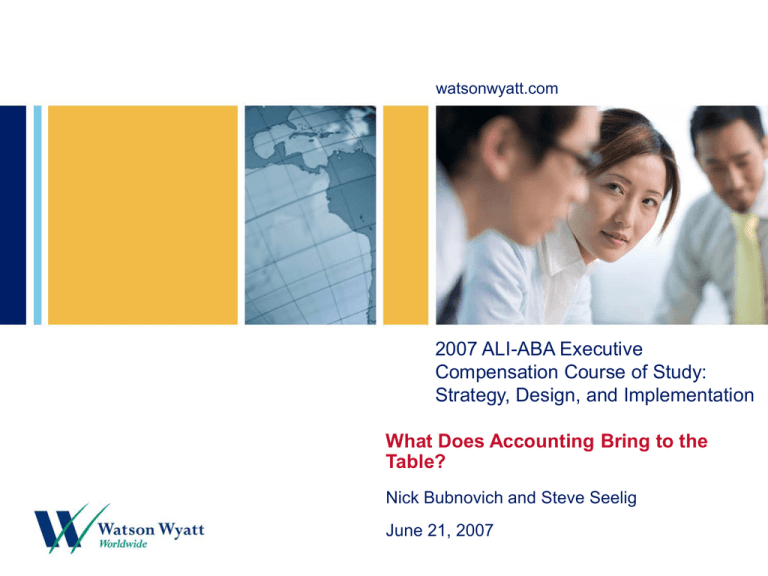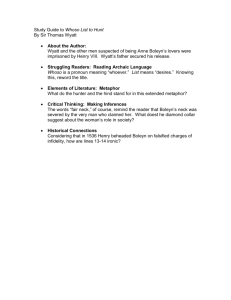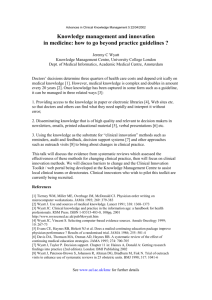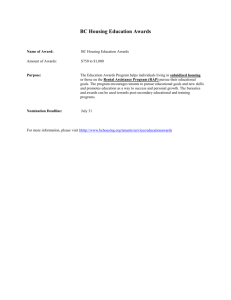
watsonwyatt.com
2007 ALI-ABA Executive
Compensation Course of Study:
Strategy, Design, and Implementation
What Does Accounting Bring to the
Table?
Nick Bubnovich and Steve Seelig
June 21, 2007
Introduction / Agenda
This presentation provides an overview of how FAS 123R affects the
proxy disclosure of different elements of compensation
Topics are presented in the following main categories:
The September 8, 2006 rules
The December 29, 2006 amendment
What is total compensation?
A Taste of FAS 123R
How’d That Happen?
2
Copyright © Watson Wyatt Worldwide. All rights reserved
Overview
The Final Regulations issued September 8, 2006 required
equity grant disclosure in several tables
Compensation Discussion
and Analysis
Summary Compensation Table
Grants of PlanBased Awards
DB Retirement
Outstanding Equity
Awards at Year-End
DC Nonqualified
Equity Realized
During the Year
Termination Payments
3
Copyright © Watson Wyatt Worldwide. All rights reserved
December 29, 2006 – Major Changes
Summary Compensation Table equity grants disclosed at their grant
date fair value under FAS 123R, as disclosed on the financial
statement
SEC Disclosure
September 26, 2006
December 29, 2006 amendment
Vesting Schedule
Disregarded
Expense to be amortized over the
service period
Performance
Conditions
Disregarded at grant
date unless “probable”
Expense recognized when “probable”
Market Conditions
Included in Fair Value
Included in Fair Value
Estimates of
Forfeitures
Taken into account in
initial disclosure
Disregard estimates of forfeitures in fair
value calculations – prior expense
recaptured in year of forfeiture
Prior year grants
Not recognized
Those expensed during the current year
are disclosed
Variable Expenses
Not recognized in
subsequent periods
Disclosed in the year expense is
recognized
Dividends and DEUs
Not recognized
Not recognized
4
Copyright © Watson Wyatt Worldwide. All rights reserved
December 29, 2006 – Major Changes
continued
Example: 100 SARs and 100 RSUs granted on 1/1/03, 1/1/04, 1/1/05 and
1/1/06 assuming a constant $10 per share stock value each year with a 4 year
vesting schedule. Black Sholes value = 33%; 7% annual forfeiture rate
Name and
Principal Position
(a)
Stock Awards ($)
(e)
Option Awards ($)
(f)
Total ($)
(j)
$279
$1,116
September 26, 2006
2006 Grant
$837
December 29, 2006 amendment
2003 Grant
$1,000/4 = $250
$333/4 = $83
$333
2004 Grant
$1,000/4 = $250
$333/4 = $83
$333
2005 Grant
$1,000/4 = $250
$333/4 = $83
$333
2006 Grant
$1,000/4 = $250
$333/4 = $83
$333
PEO Total
$1,000
$333
$1,333
5
Copyright © Watson Wyatt Worldwide. All rights reserved
December 29, 2006 – Major Changes
continued
Some companies have included a supplemental table using the old
rules
– (1)Fair value, as determined under FAS 123R, of target performance shares, for the
performance period January 1, 2007 through December 31, 2009, and restricted
stock unit awards. These have been valued based on the grant date fair value
estimated by the Company for financial reporting purposes on February 22, 2007
($28.80 per share for the performance shares and $25.87 per share for the
restricted stock units) and may not reflect the value of the award upon payment.
6
Copyright © Watson Wyatt Worldwide. All rights reserved
What is Total Compensation?
continued
AP: CEO received $15.2 million in compensation last year: salary, bonus, incentives,
perks, above-market returns on deferred compensation and the full FAS 123R value.
WSJ: CEO earned $8.3 million in salary and bonus.
CNN/Money: CEO received $17.9 million in compensation last year.
Reuters/Corporate Library: CEO pay at $13.1 million. The story indicates they
assigned a higher value to his option component and lower to his stock awards.
7
Copyright © Watson Wyatt Worldwide. All rights reserved
A Taste of FAS 123R
Cost to be recognized over requisite service period
– Period during which an employee is required to provide
service in exchange for an award - often the vesting period
– Service period may have to be derived for awards with
certain types of performance conditions that are not timespecific
Example: RSUs vest when share closing price is $30
– If there is no requisite service period, full expense is
recorded up-front
Example: RSUs that fully vest at normal retirement age
regardless of the vesting schedule for an employee who
already has attained that age
SEC Disclosure
Vesting Schedule
September 26, 2006
Disregarded
December 29, 2006 amendment
Expense to be amortized over the service period
8
Copyright © Watson Wyatt Worldwide. All rights reserved
A Taste of FAS 123R
continued
Recognition Where Only Service Conditions Exist
– FAS 123R allows alternative approaches for stock awards with
graded vesting
Can use front-loaded (FIN 28) or straight-line approach
– FIN 28 treats each vesting tranche as a separate grant (with a
separate straight-line requisite service period for each tranche)
– The following comparison illustrates the portion of cost recognized
each year (based on four-year graded vesting):
Attribution
Method
Straight Line
FIN 28
Approximate Percent of Cost Recognized Each Year
1
2
3
4
25%
25%
25%
25%
52% *
27%
15%
6%
* 25% of grants - 1 year vest (25%); 25% of grants – 2 year vest (12.5%);
25% of grants – 3 year vest (8.33%); 25% of grants – 4 year vest (6.25%)
9
Copyright © Watson Wyatt Worldwide. All rights reserved
A Taste of FAS 123R
continued
Example: 100 SARs and 100 RSUs granted on 1/1/03, 1/1/04, 1/1/05 and
1/1/06 assuming a constant $10 per share stock value each year with a 4 year
vesting schedule. Black Sholes value = 33%
Name and Principal
Position
(a)
Stock Awards ($)
(e)
Option Awards ($)
(f)
Total ($)
(j)
Straight Line
2003 Grant
$1,000 * 25% = $250
$333 * 25% = $83
$333
2004 Grant
$1,000 * 25% = $250
$333 * 25% = $83
$333
2005 Grant
$1,000 * 25% = $250
$333 * 25% = $83
$333
2006 Grant
$1,000 * 25% = $250
$333 * 25% = $83
$333
PEO Total
$1,000
$333
$1,333
FIN 28
2003 Grant
$1,000 * 6% = $ 60
$333 * 6% = $ 20
$ 84
2004 Grant
$1,000 * 15% = $150
$333 * 15% = $ 50
$210
2005 Grant
$1,000 * 27% = $270
$333 * 27% = $ 90
$378
2006 Grant
$1,000 * 52% = $520
$333 * 52% = $173
$728
$333
$1,333
PEO Total
$1,000
10
Copyright © Watson Wyatt Worldwide. All rights reserved
A Taste of FAS 123R
continued
Performance and Market Conditions
– Performance Conditions (net income or revenue target)
Vesting measures based on performance metrics that are not stock
price related
Not factored into the award's grant-date fair value
However, the “probable” outcome of that performance condition (i.e.,
will vesting occur) does influence the compensation cost
If condition is not met, ultimately no recorded compensation expense
– Any previously recorded charge for unvested options are reversed
– Market Condition
Stock price, a market index, or intrinsic value such as Total
Shareholder Return (TSR)
A factor in determining the award's grant-date fair value.
Company must record a compensation expense regardless of
whether the condition is met or option becomes exercisable.
SEC Disclosure
September 26, 2006
December 29, 2006 amendment
Performance Conditions
Disregarded at grant date
unless “probable”
Expense recognized when “probable”
Market Conditions
Included in Fair Value
Included in Fair Value
11
Copyright © Watson Wyatt Worldwide. All rights reserved
A Taste of FAS 123R
continued
Performance and Market Conditions
Example
Restricted stock grant at $10 stock price with 1 year vesting
Service
Market
Performance
Condition
Continued
service only
TSR exceeds
peer group
Revenues
increase 10%
Grant Date FV
$10
$7
$10
Expense - Condition
Met
$10
$7
$10
Expense - Condition
Not Met
$0
$7
$0
Expense – Quit
before 1 year
$0
$0
$0
12
Copyright © Watson Wyatt Worldwide. All rights reserved
A Taste of FAS 123R
continued
Forfeiture Assumptions
– FAS 123R expense is recognized based on shares granted
minus assumed forfeitures (non-vested cancellations)
– Over the vesting period, the expense is reconciled to the
number of actual forfeitures experienced – Can create
negative numbers
– Two approaches to true-ups:
Monitor: Companies may monitor experience versus
assumed and establish a variance threshold to determine
when to true-up
True Up: Companies may true-up each period to reflect the
current period’s experience versus assumed
SEC Disclosure
Estimates of Forfeitures
September 26, 2006
Taken into account in
initial disclosure
December 29, 2006 amendment
Disregard estimates of forfeitures in fair value
calculations – prior expense recaptured in year
of forfeiture
13
Copyright © Watson Wyatt Worldwide. All rights reserved
A Taste of FAS 123R
continued
Forfeiture Assumptions
Example
100 options granted with a $10 fair value and 2-year cliff vesting
10% initial assumed forfeitures
Actual forfeitures of 2% in Year 1 and 5% in Year 2
Monitor
True Up Each Period
Year 1 Expense
$450 (= 100 * 90% *
$10 divided by 2)
$465 (= 100 * 93% *
$10 divided by 2)
Year 2 Expense
$480 (= 100 * 93% *
$10 minus $450)
$465 (= 100 * 93% *
$10 minus $465)
Total Expense
$930
$930
14
Copyright © Watson Wyatt Worldwide. All rights reserved
A Taste of FAS 123R
continued
Equity v. Liability Awards
– Equity awards are those that are settled in shares
Equity awards are generally measured at fair value at
grant (fixed)
– Liability awards are generally those that are settled in cash
or remove the risk of stock ownership from participants (i.e.,
those with certain repurchase features)
– Liability awards are re-measured at fair value at each
reporting date until they are settled (variable)
SEC Disclosure
Variable Expenses
September 26, 2006
Not recognized in
subsequent periods
December 29, 2006 amendment
Disclosed in the year expense is recognized
15
Copyright © Watson Wyatt Worldwide. All rights reserved
A Taste of FAS 123R
continued
Equity v. Liability Awards
Equity Instruments
Liability Instruments
Characteristic
Expected to be settled in shares
Expected to be settled in cash
Cost Based On
Fair value of Award at Grant Date
(fixed)
Fair value of award marked-tomarket while outstanding (variable)
Cost
Recognized
Over service period
Through settlement
Stock Options
Stock settled SARs
Examples:
Restricted Stock
Stock settled RSUs
Performance Shares
ESPPs
Cash settled SARs
Cash settled RSUs
Performance Cash
Other awards (where fair value not
measured at grant)
16
Copyright © Watson Wyatt Worldwide. All rights reserved
A Taste of FAS 123R
continued
Equity v. Liability Awards
Example
100 SARs granted on 1/1/2006 at $10 with one year vesting
December 31, 2006 stock price is $15
SARs are exercised on July 1, 2007 at $20
Stock Settled
Cash Settled
1/1/06 fair value
$5.00
$5.00
12/31/06 fair value
N/A
$7.50
2006 expense
$500
$750
2007 expense
$0
$250
17
Copyright © Watson Wyatt Worldwide. All rights reserved
A Taste of FAS 123R
continued
Dividends and DEUs
– If dividends are not paid on restricted stock during vesting
period, then reduce fair value by present value of expected
forgone dividends
– If dividends are paid, then fair value is not reduced
– If awards do not vest and dividends are not returned, the
payments are reflected as compensation expense
– Dividend equivalents receive the same treatment
SEC Disclosure
Dividends and DEUs
September 26, 2006
Not Recognized
December 29, 2006 amendment
Not Recognized
18
Copyright © Watson Wyatt Worldwide. All rights reserved
A Taste of FAS 123R
continued
Dividends and DEUs
Example
1 share of restricted stock granted at $10 with one year vesting
$1 dividend payment expected
Dividend Paid
and RS Vests
Dividend Paid and
RS Doesn’t Vest
Dividend Not Paid on
RS and RS Vests
FAS 123R
Expense
$10
$0
$9
Other Comp.
Expense
$0
$1
$0
19
Copyright © Watson Wyatt Worldwide. All rights reserved
How’d That Happen?
Negative Numbers
– The cause here was a share-based plan that settled in cash as mark-tomarket accounting can create negatives due to stock price declines - FAIR
GAME; Weird and Weirder Numbers on Pay Reports, NY Times, 3/11/07
– Example: Executives permitted to reinvest bonus into deferred share units
whose value is based on company stock but is settled in cash. Such plans
might be perceived positively as they align executive/shareholder interests
(2) Dollar amounts in the Stock Awards column reflect the compensation expense/(income) recognized for deferred share units
during the 2006 fiscal year in accordance with SFAS 123R, “Share-Based Payment.”
(3) The Company has recorded the intrinsic value of these options as a liability using variable plan accounting. The liability is
expensed over the vesting period and re-measured at each reporting date to reflect the current intrinsic value because options can
be settled in a cash amount equal to the difference between the market price of the shares underlying the option and the exercise
price of the option.
– Note: no negatives would appear if full grant date value is shown (9/26/06 rule)
20
Copyright © Watson Wyatt Worldwide. All rights reserved
How’d That Happen?
Big Numbers
– The other side of the coin: executive is retirement eligible and company
adopts a share-based plan that will settle in cash and stock price rose
during the year
2 The SEC rules require that the amounts in this column reflect the 2006 accounting expense incurred by the Company in
accordance with SFAS 123(R) for the PSUs and RSUs granted to the named executive officers. Because all the named
executive officers are retirement eligible, the Company is required to include in these amounts the entire expense of the 2006
PSU and RSU awards. In addition, because the 2006, 2005 and 2004 awards are payable in cash, the Company is also
required to include in this amount for 2006 any increase or decrease in the price of ______ stock and any dividend equivalents
accrued with respect to these awards. The amounts in this column do not represent the grant date fair value of the 2006 awards
granted, nor the amounts that will necessarily be paid to the named executive officer.
21
Copyright © Watson Wyatt Worldwide. All rights reserved
How’d That Happen?
Big Numbers
– Example: Executives receive RSUs settled in cash, but the plan
requires retention until the executive’s retirement
The Summary Compensation Table columns include the Financial Accounting Standards Board Statement
No. 123(R), “Share-Based Payment” (FAS 123(R)) expense recognized by the Company in the year for all
outstanding stock and option awards, which, because of the “hold-until-retirement” feature of our restricted
stock/restricted stock unit programs, can be a substantial amount. Because we require our executives to hold
restricted stock and restricted stock unit awards that have performance-vested until they retire, any
appreciation in our stock price during a given year results in the Company recognizing the value of such
appreciation with respect to certain previously-earned awards in its financial statements, and therefore, in the
Summary Compensation Table.
22
Copyright © Watson Wyatt Worldwide. All rights reserved
How’d That Happen?
continued
SERPs
– Pension values will increase on a steep slope until the NEO’s retirement
– Changes in actuarial value are reported in column (h) based on FAS 87
reporting assumptions:
The change in value due to an additional year of service, compensation
increases (decreases), and plan amendments (if any); and
The increase (or decrease) in value attributable to interest
– Example: SERP for incoming CEO to provide a $5 million present value
SERP benefit in 10 years at age 60
Name and
Principal
Position
Year
Salary
($)
Bonus
($)
Stock
Awards
($)
Option
Awards
($)
Non-Equity
Incentive
Plan Comp
($)
Change in
Pension and
NQDC
Earnings
($)
All
Other
Comp
Total
($)
(a)
(b)
(c)
(d)
(e)
(f)
(g)
(h)
(i)
(j)
PEO 2007
$205,745
PEO 2016
$1,034,272
23
Copyright © Watson Wyatt Worldwide. All rights reserved
How’d That Happen?
continued
SERPs
– There are situations where the Pension values will decline
“Total Compensation. Total compensation as reported in the Summary
Compensation table decreased 21% from 2005 to 2006 for listed officers,
primarily because of the decline in incentive cash compensation and the
decrease in reported pension plan benefits. While the change in reported
pension values decreased sharply, the reason for the decline was that the total
value of the tax-qualified pension plan arrangement was reported in 2005
because this was the year the arrangement was established, and only the
change in the value of this arrangement from the prior year was reported in
2006.
24
Copyright © Watson Wyatt Worldwide. All rights reserved
How’d That Happen?
SERPs
– Alternative: grant Career Service Shares with a delayed vesting date:
– Stock grants reported in column (e) based on FAS 123R financial
statement value amortized over vesting schedule
– Example: Grant $2.5 million of restricted stock that vest in 10 years at age
60. Assumes stock price doubles in value by December 31, 2016. Total
amount reported will equal $2.5 million – much less than the amount that
would have been reported in column (h)
Name and
Principal
Position
Year
Salary
($)
Bonus
($)
Stock
Awards
($)
Option
Awards
($)
Non-Equity
Incentive
Plan Comp
($)
Change in
Pension and
NQDC
Earnings
($)
All
Other
Comp
Total
($)
(a)
(b)
(c)
(d)
(e)
(f)
(g)
(h)
(i)
(j)
PEO 2008
$250,000
PEO 2016
$250,000
25
Copyright © Watson Wyatt Worldwide. All rights reserved
Comparing SERPs to Career Service Shares
SERPs
Career Service Shares
Summary
Compensation
Table (SCT) Value
Change in pension values disclosed
on the SCT tend to increase from
year to year as executive nears
retirement
Value disclosed on the SCT is based on the
grant date stock fair market value, amortized
over the service (vesting) period, without
taking into account future increases in stock
value
Proxy Values on
Other Tables
Entire accrued value of the SERP
to be disclosed on the Pension
Table, whether or not vested,
creating a perception of high dollars
provided to executives
Disclosed based on number of shares
outstanding. Potential dollar value of
payment would need to be separately
calculated
NEO
Determination
Change in Pension Values are
excluded in determining whether an
executive is an NEO
Value disclosed on SCT is included in
determining whether an executive is an NEO
26
Copyright © Watson Wyatt Worldwide. All rights reserved
Comparing SERPs to Career Service Shares
SERPs
Career Service Shares
“At Risk” Pay
Perceived as providing fixed pay
disconnected from the performance of
the executive or the company
Are “at risk” both because of future cliff
vesting and potential fluctuations in stock
values
Accounting
Costs
Tend to be volatile costs due to
discount rate changes and
compensation increases/decreases
Will remain steady over the vesting period as
the fair value at grant date will not be
adjusted for stock price increases
Alignment With
Shareholders
Arguably, little alignment with
shareholders
Increases the portion of total compensation
that is based on creating shareholder value
through stock value appreciation
Retentive Value
Depends on vesting: less where
vesting is same as qualified plan than
where vesting is delayed until or near
retirement age
Arguably, improves retention of management
by increasing the portion of compensation
that management "leaves on the table" if
employment is voluntarily terminated
27
Copyright © Watson Wyatt Worldwide. All rights reserved
How’d That Happen?
The Case of the Missing Corporate Income Tax
– The WSJ reported that many “profitable” tech companies pay lower
corporate income tax than initially claimed for financial statement purposes
- Tech Titans' Tax Picture Is Clouded by Options, C1, April 15, 2007
– When estimating the future tax benefit of option grants, the WSJ
determining that several tech companies assume a higher tax rate than
their true effective tax rate
According to WSJ, Google assumed an effective tax rate of 23% even
though appreciation in stock value generated a high tax deduction for
options exercised and RS vested that, in turn, reduced its tax rate to
8.8%
– In accounting lingo, there is a book-tax difference between the deferred tax
asset created at the time the stock option is awarded (based on the BlackSholes value) and the actual tax deduction later taken
– The FASB thoroughly vetted this issue and decided generally not to permit
companies to recognize expenses or income related to true-ups between
book-tax differences
28
Copyright © Watson Wyatt Worldwide. All rights reserved
How’d That Happen?
continued
The Case of the Missing Corporate Income Tax
– Hearing held by Homeland Security and Governmental Affairs Permanent
Subcommittee on Investigations on June 5th
– Reviewed nine companies and determined $1 billion more in tax
deductions than booked expenses, had FAS 123R been in effect from 2002
to 2006.
– Chairman Levin’s position:
Compensation committees are aware of the potentially "whopping tax deduction"
and use it as an incentive to grant a higher number of options to executives
Because options are not subject to 162(m), he argues that taxpayers "subsidize
millions of dollars in executive pay“
He also believes that the book-tax difference is fueling the increasing gap
between executive pay and that of the average worker.
– Legislation is expected to be proposed in the fall to match the tax deduction
to the same year expenses are shown on a company’s books
– Issues to be resolved:
What are the revenue estimates?
How to transition in for existing grants?
How are performance vested options and cash-settled SARs treated?
Would this apply to restricted stock and RSUs?
29
Copyright © Watson Wyatt Worldwide. All rights reserved
How’d That Happen?
Grant Date Accounting and Negative Discretion under
Section 162(m)
– A “grant date” cannot occur until employee and employer have a
mutual understanding of the key terms and conditions of the award
(Example: the number of shares to be granted)
– Under a “negative discretion” 162(m) plan with performance
shares, it might be argued that the grant date does not occur until
the compensation committee determines the number of shares that
will be paid
– Thus, the grant date doesn’t occur until after the performance
period concludes, making all the shares subject to variable
accounting
– Better view among the accounting firms is there is no bright line
test and each case is evaluated on a facts and circumstances
basis
30
Copyright © Watson Wyatt Worldwide. All rights reserved
One More Thing
Financial Interpretation No. 48, Accounting for Uncertainty
in Income Tax
– Companies required (generally as of 1/1/07) to create more
extensive disclosures about the tax positions the company is
taking
– An estimate is also required of how the denial of a tax deduction
could affect the future cash position of the company
– Companies have always been required to estimate a tax cushion,
but the new rules require far more extensive disclosures than in
the past
– SEC staff says that it expects to see some changes in the
contractual obligations table of the MD&A section of the 10-K,
resulting from companies’ analysis of outstanding tax positions in
accordance with the new rules
31
Copyright © Watson Wyatt Worldwide. All rights reserved







